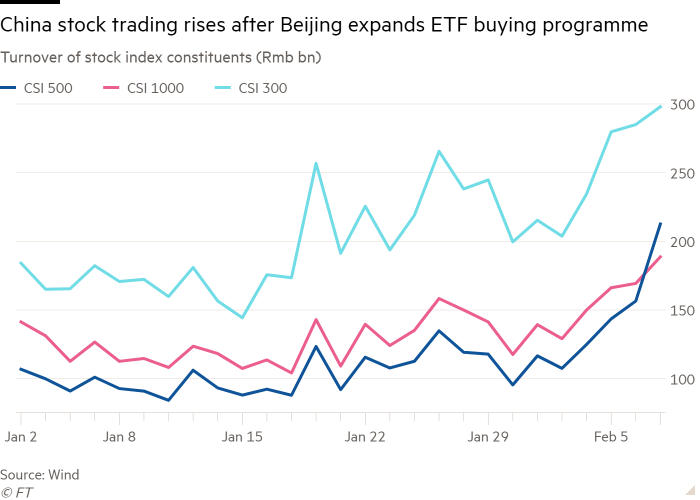China stock trading surges after Beijing unveils more state-led buying

Roula Khalaf, Editor of the FT, selects her favourite stories in this weekly newsletter.
Trading activity in China’s largest listed companies has surged to a five-month high, reflecting what analysts said was a likely increase in buying by Beijing’s “national team” of state-run financial institutions.
Daily turnover for stocks included in the CSI 300, CSI 500 and CSI 1000 indices — which together account for the majority of the Chinese stock market’s trading activity — rose to Rmb699bn ($98.3bn) on Wednesday, the highest level since August 28, according to Financial Times analysis of figures from Chinese data provider Wind.
The CSI 300 index, which contains the largest and most liquid Shanghai- and Shenzhen-listed stocks, is up 4 per cent this month, after shedding more than 6 per cent in January.
Chinese authorities have repeatedly tried to boost stock market confidence. On Wednesday, state media announced the removal of Yi Huiman, the powerful Communist party boss and chair of the China Securities Regulatory Commission, a move seen by financial sector observers as making him a scapegoat for recent share price falls.
The latest rise in trading activity comes after Central Huijin, an investment arm of the country’s sovereign wealth fund, announced on Tuesday it would expand its purchases of exchange traded funds. The CSI 500, CSI 1000 and CSI 300 indices jumped after the announcement.
“Valuations are at a reasonable level for the national team to buy in,” said Xia Chun, chief economist at Forthright Financial Holdings in Hong Kong. “Besides, any [retail] investors who had the money to invest in stocks have basically lost everything already.”
Chi Lo, senior Asia-Pacific strategist at BNP Paribas Asset Management, said the scale of state buying was not clear.
But he added that the sharp sell-off in Chinese equities in January had “scared Beijing” and that recent policy announcements showed that officials were “trying to short-circuit that downward momentum”.

Trading volumes in some exchange traded funds tied to the CSI 300 surged following Wednesday’s announcement, with volumes of two ETFs linked to the index managed by Harvest Fund Management and China Asset Management reaching record highs, according to Wind. A similar ETF managed by a joint venture between PineBridge and Huatai Securities also showed a significant rise in activity.
The total daily turnover of Shanghai- and Shenzhen-listed stocks also passed Rmb1tn on Wednesday for the first time since November 21.
China’s national team came out in force during the country’s 2015 stock market meltdown, with more than 20 large or state-affiliated institutions, including Citic Securities and Haitong Securities, buying stocks across the board to try and prop up valuations.
Despite steady stock market losses over the past six months, Beijing has so far held back from such significant market intervention. This year official buying appears to be concentrated among a few state investment arms, including Central Huijin, a unit of sovereign fund China Investment Corp, and China Reform Holdings Corp, a Beijing-based money manager of state assets.
Purchases by those state investors have been limited to shares in state banks and ETFs that track benchmark indices — far more restrained than 2015’s buying spree.
Chinese authorities have proposed setting up a stock market stabilisation fund to boost flagging confidence among domestic investors, the Financial Times reported in October, but analysts said there was little evidence so far of supportive buying by any such fund.
Nevertheless, analysts at HSBC wrote in a note on Wednesday that “the recent market turmoil may prompt more decisive and quick moves by the national team to help restore confidence and prevent a self-fulfilling cycle”.
Comments